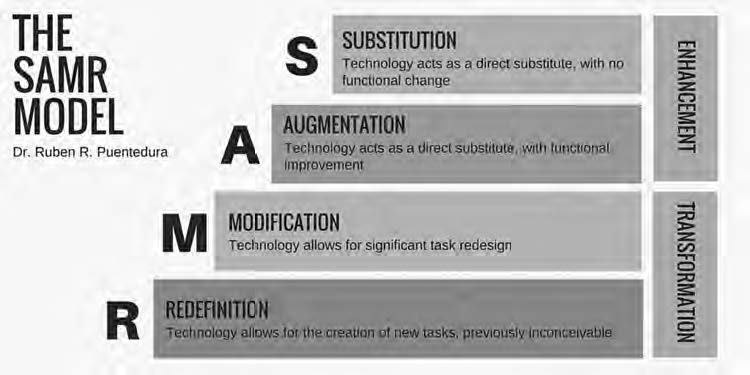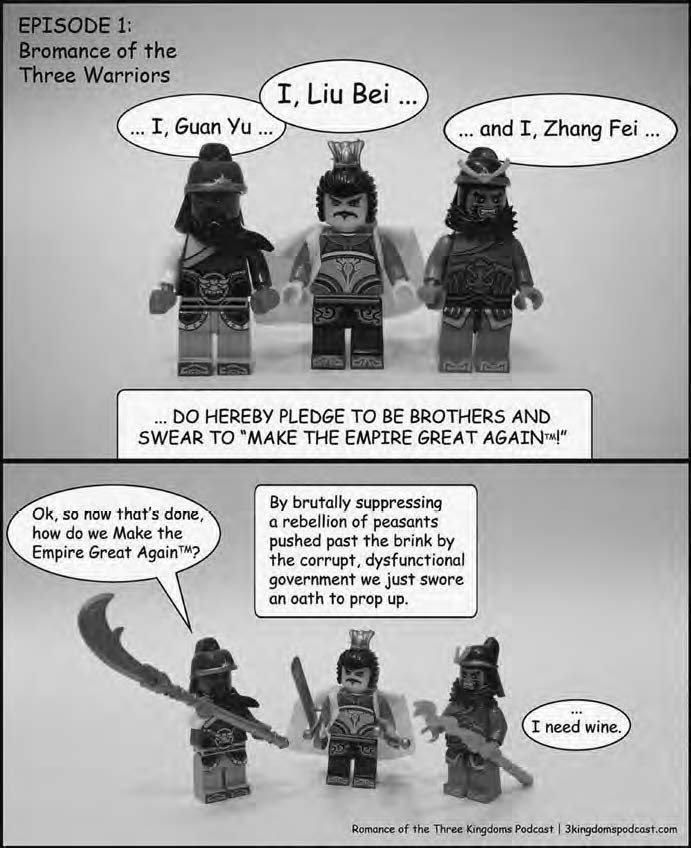It is hard to imagine a secondary- or college-level course today that is absent of technology. At the Hotchkiss School, the independent secondary school where I teach, all instructors use Canvas to post assignments and make use of one or more Google apps. Some make digital tools still more central to student learning, incorporating Kahoot! quizzes (https://kahoot. com), website creation, and even 3-D printing into their classes. All of this leaves me wondering how to make sense of these digital interventions in teaching.
One compelling answer is the “SAMR model,” a framework for evaluating digital learning. The SAMR model differentiates the stages of substitution, augmentation, modification, and redefinition, and was created by Ruben Puentedura, a widely cited writer on education technology who now heads the Massachusetts-based consulting firm Hippasus (http://www.hippasus.com). Puentedura’s goal in breaking down the SAMR components is to encourage educators to utilize technology to add value rather than simply replacing analog tools with digital ones.
In this article, I will apply the SAMR model to the Three Kingdoms project I developed in my upper-level (grades 11–12) Chinese history elective at the Hotchkiss School. The goal of the project is to encourage students to think about different ways of engaging the past (history, historical literature, and historical memory), and to present what they learn in a group presentation for their parents as an authentic audience. Our main focus is one of “China’s four great novels,” The Romance of the Three Kingdoms (Sanguo yanyi 三國演義), set during the final years of the disintegrating Han dynasty (220–280 CE). Appropriately for our study, the text was first authored in the fourteenth century, then published and more widely circulated in the sixteenth century, and now read by us today in translation. Our investigation begins with joint discussion and includes a longer middle period of small-group research, with each team taking a deeper dive into a particular scene from the novel involving Zhuge Liang. It concludes with presentations and reflections.

This project is a useful backdrop for introducing the SAMR framework and examining the varying roles technology plays in facilitating this project.
SUBSTITUTION
The most basic digital intervention in teaching is substitution. Simply, substitution involves taking an activity that had been done previously with pen and paper and now asks students to use a laptop or tablet to complete the same activity. In the past, I had used a paper survey for feedback; I now use Google Forms to ask the same questions. I could make the case for modest efficiencies in deployment or archiving, but the process is essentially a one-for-one swap.
During the Three Kingdoms project, one way I utilized substitution is to scan excerpts from Moss Roberts’s translation of the Romance of the Three Kingdoms and distribute them as downloadable PDF documents rather than as printed copies. Doing so saves time and resources of printing on my part and streamlines the rollout process for the project. It also transfers the hassle of printing to my students and in effect incentivizes on-screen reading, which studies suggest is a less effective method for digesting information. Recognizing this practice as substitution is a good opportunity to reflect on how and why I distribute readings the way I do.
AUGMENTATION AND MODIFICATION
The divide between the next two levels—augmentation and modification— is consequential because it marks the crucial divide between merely “enhancing” and more profoundly “transforming” how learning occurs. At the same time, this can be the point in the model that can be hardest to differentiate in practice. Augmentation is when a digital tool provides a boost to students’ abilities to complete a task or engage in deeper learning within the context of a project that would have otherwise been feasible. A modification, by contrast, involves similar gains, but also initiates a modest transformation of the task itself.
Google Docs can provide a simple illustration of a tool that straddles this boundary. My students write their papers by typing them, then receive intext comments from peers and then from me. This approach represents augmentation, since the real- time nature of the platform facilitates two-way commenting: a student could potentially receive feedback, respond to feedback, and then repeat the process a handful of times in the same time they would normally get their first responses. When used this way, Google Docs is a more efficient way of facilitating a familiar writing process. However, at other times, the same tool becomes a form of modification when multiple students are able to combine source investigation and “silent discussion” by collaborating on a common Google Doc as a form of collective output. This approach has the potential to alter discussion dynamics in favor of quieter students and sets the stage for new types of group work, like creating a visual timeline.
The Three Kingdoms project utilizes both augmentation and modification. Earlier, I identified the distribution of PDF documents as a form of substitution. Together with those readings, I also assign two sets of podcasts as additional “readings,” an approach that might be better understood as augmentation. All students share in listening to an episode of BBC Radio 4’s In Our Time (https://tinyurl.com/yauzgf7r) in which Melvyn Bragg hosts a roundtable with three scholars: Frances Wood, Craig Clunas, and Margaret Hillenbrand. Students then receive a second podcast episode from John Zhu’s spectacular Three Kingdoms Podcast (https://tinyurl.com/ jy5cgxz) that aligns specifically to the scene their group will be investigating. Whereas BBC models scholarly discussion, Zhu hints at how to translate the text into a more animated, vernacular performance. In both cases, the spoken character of the podcasts would not have been easily replicable in transcript form. Mixing up assignments also proves popular with students, one of whom “felt as if I was taking in information far better than before and also enjoy[ing] it.”

Video recording the presentations—my last and perhaps simplest intervention— would be a modification because of the way it alters the nature of the audience, and therefore the assignment. Students know from the outset that they are not performing merely for one another, but for their parents as well. They therefore have to think about how to contextualize the material for an educated audience that is not uniformly knowledgeable about Chinese history. However, the special schedule for Parents Weekend meant that our class would not meet as initially planned, which meant that video recording served as the link connecting students to a larger audience of parents.
REDEFINITION
Redefinition involves utilizing technology to fundamentally reimagine how learning happens, opening up possibilities that did not previously exist. For many students, such lessons represent novel and engaging opportunities. Transformation of learning along these lines is a high standard, admittedly not one I often reach in my classes, even during the Three Kingdoms project.
I can imagine several ways we might have adjusted our unit design so it would qualify as redefinition. Groups might have been tasked with curating their own presentations in a way that could have included either website creation via Google Sites or Weebly (https://www.weebly.com), or video editing utilizing iMovie. Alternatively, we might have experimented with creating an interactive map overlay on Google Maps to translate one or more of the scenes spatially; this would have worked especially well for the “Battle at Red Cliff.” If facilitated carefully, such additional steps would have further challenged students to connect with their audience—perhaps one defined more broadly than just their parents. And at the same time, it is just as certain that such extra steps would have required further skills training and more time to complete. For example, the last time I had students create a website, we allotted a little over a week to the drafting stage. In a written reflection, one student reported anonymously feeling “stressed” and asked me to consider “two or three weeks” for future students to complete that portion of the task. Such feedback led me to stop short of redefinition in planning the Three Kingdoms project because the modification stage had already provided the most balanced path toward our learning objectives.
This last point about the limits of innovation is worth discussion. It points to a subtle if important limitation of the SAMR model: it places technology at the center rather than learning. After all, “transformation” refers to the degree to which technology provokes a fundamental change in instruction, with technology serving as the subject and instruction as the object. For educators already committed to promoting critical inquiry and creativity in their classrooms, such a transformation is likely to align with activities targeting the upper reaches of Bloom’s taxonomy. Yet, there is nothing inherent in the SAMR model itself linking the two.
Despite this important caveat, I have found that the SAMR model encourages me to think and find myself encouraged to think more critically about, the role technology plays in project-based exercises like the Three Kingdoms Project, and in my teaching more generally. Reflecting on the SAMR model reminds me of the degree to which digital tools have become a nearly constant presence in my teaching practice and the challenge of drawing on them most productively to facilitate student learning. ■

